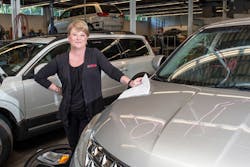One day, Lisa Siembab’s office manager came to her with a problem. Somebody had come in to apply for the technician position open at the shop, but this particular applicant couldn’t fill out the application.
“He spoke almost zero English,” says Siembab, owner of CARSTAR Berlin in Berlin, Conn. “And, personally, that didn’t bother me one bit. I took a chance on him because I believe so firmly we have to give people opportunities. How many people in this industry would have turned him away?”
CARSTAR Berlin
Location: Berlin, Conn.
Size: 10,000 square feet
Staff: 16 (9 technicians, 2 estimators, 1 office manager, 1 production/parts coordinator, 1 intern, 1 human resources director, 1 manager)
Average Monthly Car Count: 70-80
Annual Revenue: $1.9-2.4 million
Turns out it was a great decision—today, Nelson Benitez is one of her top technicians. The shop’s parts coordinator serves as a translator, and Siembab says appraisers line up to work with him because of speedy, quality repairs.
Siembab’s embracement of Benitez is indicative of her attitude toward improving the collision repair industry as a whole: If something is broken, you should fix it. So instead of idly sitting by during her 21 years in the body repair industry, she’s sought to make a difference by getting more millennials and Spanish-speaking professionals into the business.
Perhaps her biggest undertaking has been attempting to eliminate the language barrier at collision repair shops. On a micro level, she teaches English as a Second Language at a local school. But on an industry level, she’s worked with the National Auto Body Council’s In-Language Initiative to translate a glossary of collision industry terminology from English to Spanish. It’s all part of her mission to assimilate young professionals into the business as quality technicians become harder to find; she even started a student placement program for technicians graduating from technical high schools in Connecticut.
So now she’s taking all the knowledge accrued from her very impressive résumé—she once served as the marketing director for over 225 CARSTAR locations, she heads the Connecticut Collision Repair Specialists organization (now ASA Connecticut), and she currently manages a flourishing CARSTAR shop in Berlin, Conn.—and applying it on a national, statewide and individual shop level. It’s all in an effort to make the collision repair industry more open, collaborative and inviting for professionals ready to break into the trade.
AN IMAGE PROBLEM
With a degree in marketing, Siembab tends to have a broader perspective on the business. That’s why, after only a few short years working at her husband’s CARSTAR shop, corporate tapped her for the marketing director position at the corporate office. “We were very successful in gaining insurance relations,” she says. “We were very cognizant of KPIs and customer service. We just really developed good relationships here.” Well aware of the tension with insurance companies and some customers’ general wariness of the collision repair industry, Siembab worked with individual shops and marketing teams from around the country on strategies for improving these key day-to-day relationships.
Improving the industry on an individual level was one thing—but Siembab knew her marketing efforts could go bigger. That’s why she teamed up with the Collision Industry Conference (CIC) to revamp its efforts to engage with industry stakeholders, such as repairers, vendors, insurers and educators.
“[CIC] had an image problem,” Siembab says. “They were stale. The attendance wasn't what they wanted. People were saying there's no takeaway. So we looked at that, and we created several surveys that polled the attendees and we made a difference.”
The main problem? A lack of engagement from outside the actual conference. It simply wasn’t conducive to a new generation that yearns for constant feedback and information.
The key focus for getting more quality stakeholders in the industry was similar to her national marketing approach for CARSTAR: attract the millennial generation. Siembab placed a major focus on updating CARSTAR websites and making the CIC presentations available online. She worked with speakers on every single presentation to find ways of making them more engaging and inviting to new, young professionals waiting to break into the industry.
“At the time, once you attended and left, that was it,” she says. “Now you have access to the information that's presented any time you need it.”
And once she tapped into the younger market’s mindset and had moved on to manage her own CARSTAR shop in Connecticut, she realized yet another portion of the population was being alienated as well: Spanish-speaking professionals.
THE BI-LINGUAL BARRIER
Nelson Benitez worked in his father’s body shop as a child in Puerto Rico. As a young, aspiring technician, he moved to Connecticut from Puerto Rico, and for months searched for work until landing on Siembab’s doorstep in January.
Gilbert Padilla, the parts coordinator for CARSTAR Berlin, translates for Benitez when needed, and the system has worked out surprisingly well. And while he’d love to learn English to make the process easier, Benitez says “it hasn’t been easy” to find the time.
“I’m trying to make money to support my family,” he says. “I just haven’t had the time.”
“I see it all the time with my students,” Siembab says. “They’ll work all day long, and then head to a class from 6 to 8 p.m. Then you have no time for family. Not everybody can make it work.”
And while Siembab took a chance on the technician, not everybody is as lucky as Benitez. According to the U.S. Department of Labor, there was 11.5 percent unemployment rate among Latinos in 2011. That percentage could be harder to overcome, as Latinos are expected to make up 19 percent of the workforce in 2020, and 24 percent by 2050.
While 15 percent of the Latino workforce specializes in the “repair and maintenance” trade, it is difficult for most Spanish-speaking collision repair technicians to get the proper training. Gene Lopez, the northwest and southwest regional manager for I-CAR, says much of the hesitancy in providing Spanish-only curriculum for technicians lies in the various dialects coming from Spanish speaking technicians.
“Bi-lingual training—specifically from English to Spanish—has always been a challenge for any organization,” he says. “Spanish coming from Spain is different than Spanish coming from Mexico or Cuba or Puerto Rico.
“People put up a wall and say, ‘We can’t do this because of all the dialects.’ Well, that’s a shame in and of itself.”
Lopez says many of I-CAR’s classes will feature Spanish-speaking teachers translating for their students, and then providing English-only tests. But without change happening on a broader scale, Lopez says it’s difficult to properly train these technicians for collision repair.
Siembab is attempting to create that broader change and refocus the industry’s inclusion of non-English speaking employees. Her passion for teaching English as a second language—which she still does in her off-time for the Literacy Volunteers of Greater Hartford—affected the industry on a larger spectrum when she collaborated with the National Auto Body Council’s In-Language Initiative to translate a glossary of collision industry terms from English to Spanish.
The industry has been making larger strides in the last few years, she says, as the National Auto Body Council has established an In-Language Initiative, which bases its own glossary on CIC’s translations and is addressing several other language barriers outside of English-to-Spanish.
“Because good technicians are so hard to find, this is a great way to fill the void,” Siembab says. “These folks who are coming in that don’t speak English, they have this incredible work ethic. They want to get a job. They have drive. They want to be part of America. We can help them achieve that while helping ourselves at the same time.”
A FRESH VOICE
Siembab’s long-term goal is to eventually start a company that focuses on teaching collision repair terms in English—from reading repair orders to conversing with appraisers—to make the repair process go more smoothly. But in order to do that, she had to lay the seeds of her vision within her home state, which meant distancing herself from a state group’s set of philosophies on the business.
“There’s an association in Connecticut that has been here for over 50 years, and their philosophy and goals did not represent me as somebody deeply devoted to the collision repair industry,” Siembab says. “They are very anti-insurance, and they don't focus on training and education and expanding their world to include all segments of the industry. I didn't feel that that was conducive to growth.
“So I decided we needed a fresh voice that represented those shops that wanted to grow, that wanted to be part of change, that focus on training and education.”
Thus, she began the Connecticut Collision Repair Specialists (CCRS) organization, with the goal of bringing all representatives of the industry—from repairs and operators, to vendors and suppliers, to insurance companies—together for a more cooperative, collaborative environment.
All voting rights regarding changes in the organization’s policies belong to over 70 shops and their various representatives, which now includes mechanical shops, as CCRS became ASA Connecticut in January after partnering with the Automotive Service Association.
As a shop manager, Siembab knows the work she does on a national and state level needs to be incorporated locally to better her own business. That’s why, through ASA Connecticut, Siembab works with local technical high schools to create a student placement program.
“The biggest feedback we’d get from these schools was, ‘You never hire our people,’” she says. “So we stepped up and said we guaranteed placement in one of our shops in Connecticut.”
In addition, her organization began to work with state shops in obtaining more affordable training for technicians.
As the chairman for the Hartford county chair for the I-CAR Education al Committee, she convinced the training organization to offer discounted classes to ASA Connecticut members.
“We want to create the type of companies that can attract new talent,” she says. “One of the biggest issues we have in our industry is finding technicians, and if we can shape our business model around them and make collision repair more inviting from a training perspective, they’ll realize they have opportunities in this industry quickly.”
Siembab hopes that through her actions she can prove that quality technicians are available and waiting to break into the industry. For now, she has to do her part by not only enacting change in her own state, but in her own shop as well.
“You can sit in an office, sit behind a computer, and you can create all these initiatives and spreadsheets and look at the numbers, but you’ve got to get inside the shop and look at your culture,” she says. “You’ve got to talk to other shop owners. You’ve got to pay attention to your employees. Your people are your greatest assets.”

